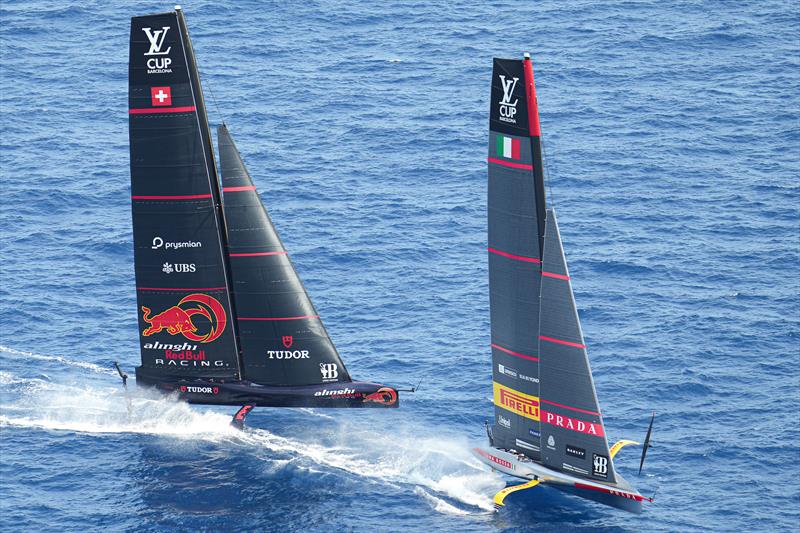
America's Cup: Analysis of Alinghi Red Bull Racing's expensive gybe
by Richard Gladwell Sail-World NZ 27 Aug 2024 07:21 PDT

Alinghi Red Bull Racing and Luna Rossa Prada Pirelli - Race Day 4 - Final - Louis Vuitton Preliminary Regatta - Barcelona - August 25, 2024 © Ian Roman / America's Cup
The most spectacular sailing in the just concluded Louis Vuitton Preliminary Event was the moment Alinghi Red Bull Racing's rudder lost its grip with the water shortly after rounding Mark 1 in Race 14.
The Swiss had just gybed and led Luna Rossa Prada Pirelli by 375 metres after the Italians made a mess of the start, starting 500 metres astern of Alinghi Red Bull Racing.
The chart derived from the racing data recorded on Alinghi Red Bull Racing shows "altitude" as one of the recorded data streams and assigns a value to it. Unfortunately, we don't know the units used, but they are consistent for the race and across both AC75s.
Reading the data off the chart below as the Swiss hurtle skywards, we can get a time of day for the incident, and by reading off a second data file - a 300,000-row spreadsheet of recorded boatspeeds, we can convert the speed of the AC75 in the immediate lead up to the incident, which is a peak of 20metres per second or 39.0kts.
According to Luna Rossa's speed data, the Italians were sailing slightly faster (but hadn't yet gybed) at 21.5m/s or about 42kts.
The plotted data below portrays the entire race rather than just looking at a narrow section.
On the chart below, we can see the blue plotted line (Alinghi's data) go vertical at approximately 12:53 hrs (UTC) and then bottom out a few seconds later. We can see from the data points that follow (which are assumed to be raw data and not smoothed) that Alinghi recovers and gets foiling again, but almost always over the complete race (again, looking at smoothed data), the Swiss AC75 is foiling at a lower height than Luna Rossa.
In the plotted data below, we look at a two-minute section covering the lead-in, incident, and aftermath. Looking carefully, it seems that there were a few minor flight control issues before the main incident. After sailing in displacement mode, the Swiss got back on their foils and continued racing, having lost close to 500 metres in the incident.
This was the first time the six teams had sailed under racing pressure in a Barcelona seaway kicked up by the easterly 110° breeze. Will others lose control if this direction of breeze and seaway occurs during the Louis Vuitton Cup? If so, it is clear that a race can swing on the turn of a dime in these conditions.
Where the data is shown as a series of dots rather than a solid line, this probably indicates the rate of acceleration in the foil height (altitude) change. The plotted data resumes as a solid line once the foil height stabilises as the crew regains control.
The graphic below shows the speed loss during the incident when the speed on the Swiss AC75 drops to 8 metres/sec (15.5kts) when they come off the foils. From the remainder of the speed plot, we can see that both AC75s have a similar bottom-end speed of about 13m/s or 25kts. Although not shown on this speed over the Ground (SOG) extract graph, Alinghi Red Bull Racing has another couple of flight control incidents after 1258 hrs.
From the graphics overlaid on the video of the incident and leg, this incident saw Luna Rossa move from 374 metres behind Alinghi Red Bull racing to 115 metres ahead or a delta of 490 metres. By plotting altitude against time in this analysis, it is easy to see how a race that looked all but won was easily lost after a single error.
(Luna Rossa, as the give-way boat, was subsequently penalised for not keeping clear of Alinghi Red Bull Racing during the "launch" incident and had to drop behind the Swiss AC75. However, the Italians regained the lead in the closing stanza of Leg 3.
Throughout the race, Alinghi Red Bull Racing appeared to be slightly slower than Luna Rossa, in a bigger seaway than seen on the previous three days. Looking generally at the Altitude vs Time, one area the Swiss might look at is whether they were flying too low in the conditions.